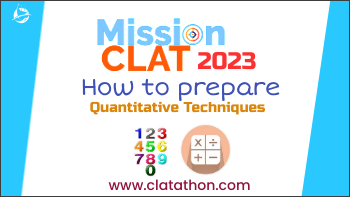As per the schedule, the CLAT 2023 will be conducted on 18 December 2022 across various exam centres in the country. Also, Common Law Admission Test for 2023 will be held for both undergraduate (UG) and postgraduate (PG) courses.
The Common Law Admission Test (CLAT) date for 2023 has been announced by the Consortium of National Law Universities. Those who are eligible and interested can register for the examination by visiting the official website - consortiumofnlus.ac.in.
The online registration process will begin soon, Aspirants are advised to keep following the official website of Consortium of NLUs to get more updates on the timetable and other details -consortiumofnlus.ac.in.
CLAT Eligibility Criteria 2023
CLAT 2023: Syllabus
Before starting your preparation, it is important for candidates to know the detailed CLAT Syllabus. It will help you know the difficult topics and easy topics as the point of the exam. Prepare a study plan as per the syllabus and start your preparation.
Check the detailed CLAT Syllabus and all the sections to be covered for comprehensive preparation.
1. English Language
2. Current Affairs/General Knowledge
3. Quantitative Techniques
4. Logical Reasoning
5. Legal Reasoning
|
English |
450 words each
|
Passages, Reading, Comprehension, Inference and Conclusion, Summary, Vocabulary etc. |
|
GK & Current Affairs
|
450 words each
|
Contemporary Events of National and International Significance, Art and Culture, International Affairs, Historical Events of significance |
|
Legal Reasoning
|
450 words each
|
Rules and Passages of Law, Application of the rules and passages, etc. |
|
Logical Reasoning
|
300 words each
|
Argument – Premise and Conclusion, Inference, Relationships and Analogies, Contradictions and Equivalence, etc. |
|
Quantitative Techniques
|
- |
Basic Algebra, Mensuration, Statistical Estimation, Graphs, Numerical Information, Ratio and Proportion etc. |
CLAT 2023 Preparation Tips: Quantitative Techniques
Quantitative Techniques section was changed from Elementary Mathematics as revised from CLAT-UG 2020. Quantitative Techniques is a section that can prove as a deciding factor for those aiming for law admissions at the prestigious National Law Universities (NLUs).
The section is also one of the easiest as it contains questions of Class 10 difficulty level only, while all other sections contain questions of Class 12 difficulty. Therefore, aspirants are advised not to ignore the CLAT Quantitative Techniques section and rather focus on clearing their concepts.
In this article, our experts at CLATATHON ( CLAT Coaching by NLU grads) have curated the best CLAT Quantitative Techniques preparation tips, books and topics to help you sail through the preparation of Quantitative Techniques section smoothly.
Try to follow all these tips and perform well in the upcoming exam.
What are the Topics under CLAT-UG Quantitative Techniques Syllabus?
Although the section holds least weightage (roughly 10 per cent) in the CLAT-UG, Quantitative Techniques is the most scoring section in the CLAT-UG exam since it comprises elementary mathematics.
The Quantitative Techniques/Maths section in CLAT is non-comprehension based. This section will comprise short sets of facts of propositions, graphs, any other textual, pictorial, and diagrammatic representation-based questions.
To arrive at the correct result, the examinee must use a variety of mathematical procedures and formulae, as the name implies. You must deduce, infer, and manipulate numerical data from texts, graphs, and other visual representations. Charts, bars, and other graphical representations will be used to answer the majority of the questions.
Important Topics in CLAT-UG Quantitative Techniques syllabus
Given below are some important topics asked in Quantitative Techniques section of CLAT 2022:
|
Mixed Grарhs |
Tаble Сhаrt |
|
Line Grарh |
Bаr Grарh |
|
Рie Сhаrt |
Саselet DI (Раssаge Bаsed) |
|
Elementary Mаthemаtiсs |
Number System |
|
Roots |
Decimal and Fractions |
|
Surds and Indices |
Average |
|
HCF & LCM |
Ratio & Proportion |
|
Interest Calculation & Discounts |
Approximation |
|
Logarithm |
HCF and LCM |
|
Profit and Loss |
Areas and Volumes |
CLAT-UG Exam Pattern: Quantitative Techniques
The Quantitative Techniques/Maths section in CLAT-UG is non-comprehension-based. It should be noted that Aspirants, who seek admission to the best National Law Universities (NLUs) in India must not ignore this section because it would only have 15-17 questions divided amongst 3/4 sets of questions.
Below is a list of questions that will be asked in Quantitative Techniques of the CLAT-UG exam:
|
Total Weightage |
10 % |
|
Type of Questions |
The section will include: Short sets of facts or propositions Graphs Other textual material Pictorial or diagrammatic representations of numerical information These items will be followed by a series of questions |
|
Ability Tested |
The section will test the candidate's ability to: Derive, infer, and manipulate numerical information Apply 10th standard mathematical operation, including ratios and proportions, basic algebra, mensuration, and statistical estimation. |
|
Standard of Questions |
10th Standard |
|
Total Marks for Logical Reasoning |
13-17 |
|
Difficulty Level |
Easy to Moderate |
CLAT-UG Quantitative Techniques Paper Analysis
Below mentioned is the paper analysis of CLAT-UG from the previous years.
The majority of students who took the CLAT exam thought the paper was too long. The exam's overall difficulty level was low to moderate.
The section has the fewest passages and MCQs, much like last year.
The section consisted of three passages and 15 multiple-choice questions.
Quantitative Techniques was the easiest section to attempt out of all of them.
CLAT-UG : Preparation Books for Quantitative Techniques
Selecting the right books for the Quantitative Techniques preparation is definitely a tough task as there are many resources available both offline and online.
We can refer to the following books for CLAT for the preparation of Quantitative Techniques section:
|
Important CLAT Books for Quantitative Techniques |
|
|
30 Days Wonder for Maths |
S Chand’s |
|
Quantitative Aptitude |
Pearson |
|
First Track Objective Arithmetic |
Arihant |
|
Class 10 NCERT book |
|
Also, check CLAT Books List
What will be My Initial Step After Collecting the Books?
- The study plan must include all the topics as per the latest syllabus.
- Allocate at least 2 hours of your daily time for preparing CLAT Maths Topics.
- Jot down the important formulas and revise them regularly.
- Maintain a notebook to jot down the formulas as this will be useful during your revision time.
Read More: Short Tricks to manage time in the CLAT
CLAT 2023: Quantitative Techniques Preparation Strategies?
The Quantitative Techniques section of CLAT -UG is one of the highest scoring areas. If you prepare well for this portion, you can easily bag full marks. Once you've had enough practise with different questions, you'll find this portion to be quite quick to solve.
Here are some study aids and preparation ideas for CLAT-UG Quantitative Techniques
Work on your Basics: The most crucial step in this part is to work on your fundamentals. You won't be able to attempt any question on time if your fundamentals are unclear. If you don't comprehend something, go back to your eighth grade text books. Memorize tables up to 20 and squares up to 30 on a regular basis.
Practice: If you don't practise regularly, you won't be able to ace this section. You don't have to spend a lot of time on it, but you should set aside at least 40-45 minutes each day to work on Quantitative Techniques. Make it а part of your regular routine.
Solve Mock Tests, Sample Papers, and Previous Year Papers: Solving question papers will provide you an understanding of how the paper is structured. You'll also be able to see how quickly you can solve the papers and where you may make improvements.
Use shortcuts: Most problems may be solved in a faster and more efficient manner. These methods can be accessible on a variety of venues online. Look for such approaches and practise them when preparing for a question. Remember that you will not be graded on the steps.
CLAT 2023: Quantitative Techniques Preparation Tips
CLAT-UG Quantitative Techniques consists of pictorials, graphs, numerical data representation and more basic mathematics. Most Quantitative Techniques preparations deal with recollecting the basic mathematics taught in class 10. The section will have 13-17 questions. Candidates must clearly understand the formulas and concepts when appearing for CLAT Quantitative Techniques.
Here are few pieces of advice which the students will find useful while studying for CLAT:
Read More & Solve: Candidates should read and practice the subject by solving some basic mathematical equations. Candidates should refer to some Quantitative Techniques Study Materials.
Revisions: Candidates should make sure they cover all topics equally while doing their revisions.
Focus: Candidates should make sure that they focus when attempting the questions in the exam. In this section, careless mistakes can cost the candidates overall score, as CLAT 2022 will have negative marking.
Time Management: Candidates should first attempt the questions they are sure about and work on the rest next. Time management is essential for the exam as previous CLAT exams have been time-consuming, so candidates should make sure they practise accordingly.
Speed and Accuracy: Candidates must make sure that they attempt the question at a good speed while being accurate with their answers
Practise Papers and Mock Tests: Candidates should try to attempt as many mock tests and practise papers as possible. It helps the candidates familiarise themselves with the section patterns and helps the candidates with scoring better marks.
How to Answer CLAT Maths Questions?
• You can expect around 13-15 questions from the CLAT Maths section.
• You need at least 20-25 minutes to solve this section.
• You do not have much time to spend reading questions again and again. So, make sure you read the passage with a focus for the first time.
• You can underline the important points in the question paper while reading the question.
• The difficulty level of each question will vary. Hence, you may require more time for tough questions.
• There is a time limit on the exam. Therefore, time management is of extreme importance.
• Try to avoid guesswork if you are not sure about an answer.
• Move to the next question if you feel that the question is tricky and time-consuming.
Will solving the Mock Test help me Score More Marks in the CLAT Maths Section?
Solving mock tests would definitely help improve your speed and accuracy on the day of the final exam and score good marks. Also, it will help you know the difficulty level of the paper and the type of question asked in the exam.
• Practicing Mock Tests for CLAT will help improve your time-management skills and build your confidence levels.
• With the help of mock tests, you can test your preparation level as well.
• You are advised to solve at least 1-2 mock tests regularly.
• Try to analyze your performance after the completion of each mock and improve in weaker areas.
To get in touch, write to us at- ask@clatathon.com
Follw us 
![]()







